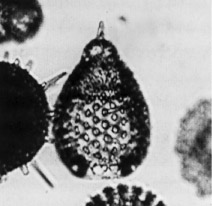 Theocotyle
cryptocephala (Ehrenberg)
Theocotyle
cryptocephala (Ehrenberg) Theocotyle
cryptocephala (Ehrenberg)
Theocotyle
cryptocephala (Ehrenberg)[?] Eucyrtidium cryptocephalum Ehrenberg, 1873, p.227; 1875, pl.11, fig.11
Theocotyle cryptocephala (Ehrenberg), Sanfilippo and Riedel, 1982, p.178, pl.2, figs.4-7 (with synonymy)
Subcylindrical to ovate in general form. Cephalis hemispherical, with few small pores, bearing horn of about same length. Thorax campanulate, with regular, circular pores. Lumbar stricture usually distinct. Abdomen subcylindrical to inflated, with greatest width medially, and regular pores consistently larger than those of thorax. Poreless peristome distinct, thick, with external contour tapered distally, and smooth margin (Sanfilippo and Riedel, 1982).
Based on 30 specimens. Maximum length excluding horn 130-190 µm, of abdomen 70-125 µm. Maximum width 100-145 µm (Sanfilippo and Riedel, 1982).
T. cryptocephala differs from T. nigriniae in its inflated abdomen with regularly arranged, consistently larger pores, and thick, tapering peristome, and from T. conica in the abdomen having its greatest width medially rather than distally (Sanfilippo et al., 1985).
The abdomen varies somewhat in length, and from subcylindrical in early forms to inflated, with greatest width medially in later forms. The abdominal pores are regular and consistently larger than those of the thorax. Early forms have a campanulate thorax often with short vestigial wings; later forms have a more conical thorax, without wings, and the shell wall becomes thicker, obscuring the lumbar stricture (Sanfilippo et al., 1985).
T. cryptocephala is found in tropical assemblages of early middle Eocene age. Its evolutionary transition from Theocotyle nigriniae defines the base of the Theocotyle cryptocephala Zone. Its evolutionary transition to Theocotyle conica lies within the Dictyoprora mongolfieri Zone.
T. cryptocephala evolved from T. nigriniae, which accompanies it for much of its range, and gave rise to T. conica.